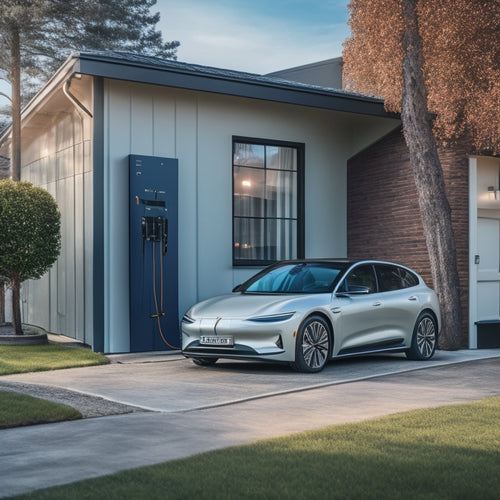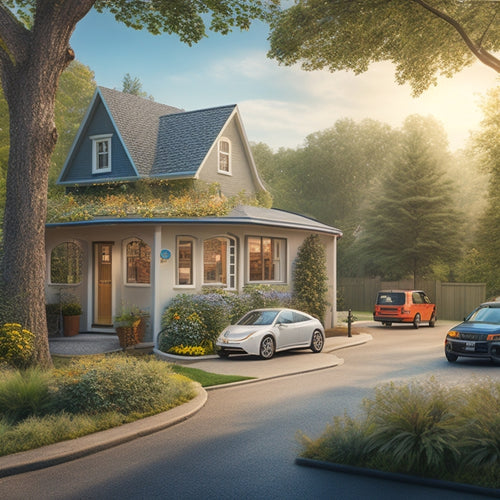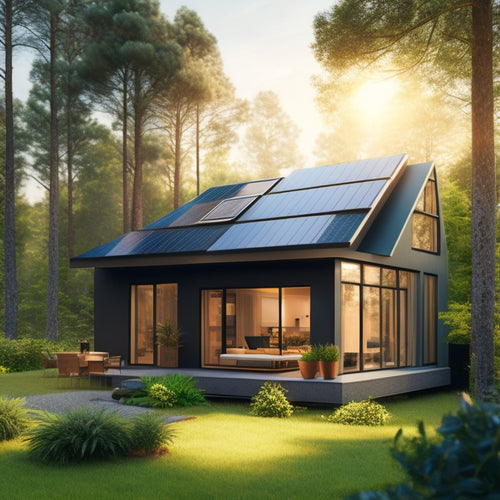
7 Key Factors Affecting Solar Installation Costs for Houses
Share
When considering solar installation for your house, you'll want to factor in seven key elements that impact the overall cost. These include your roof's size and orientation, the type and quality of panels, the installation company and labor, local building codes and permits, energy efficiency and output, battery backup and storage, and incentives and rebate programs. Each of these factors contributes to the total cost, which can range from $15,000 to $30,000 or more. Understanding how each element affects the final price will help you make an informed decision - and exploring each factor further will reveal even more opportunities to optimize your investment.
Key Takeaways
- Roof size and orientation significantly impact installation costs, with larger roofs and ideal orientations (south-facing with 15-40° pitch) being more cost-effective.
- The type and quality of solar panels influence installation costs, with higher-efficiency panels generating more power at a higher price.
- Installation company experience and labor rates directly impact installation quality, with more experienced companies often having higher labor rates.
- Local building codes, permits, and incentives can significantly affect installation costs, with compliance requirements and permitting timelines varying by jurisdiction.
- Energy efficiency and output are critical factors, as a well-designed system minimizes energy loss and optimizes generation, maximizing ROI and energy independence.
Roof Size and Orientation
Since your roof is the foundation of your solar panel system, its size and orientation play an essential role in determining the overall cost of installation. A larger roof generally requires more solar panels, which increases the cost.
However, the orientation of your roof also affects the installation cost. A south-facing roof with a pitch between 15° and 40° is ideal for solar panels, as it receives the most sunlight throughout the day. If your roof has a different orientation or pitch, you may need to adjust the installation to guarantee ideal energy production, adding to the cost.
A thorough shading analysis is also vital to determine the impact of surrounding trees, buildings, or other obstructions on your solar panel system's performance. This analysis helps identify potential issues and allows installers to design a system that minimizes energy losses.
Type and Quality of Panels
Most solar panel systems installed on houses today feature crystalline silicon panels, which come in various types and quality grades. As you evaluate your solar installation, you'll want to think about the type and quality of panels that best fit your needs.
Higher-efficiency panels, for instance, can generate more power per hour of sunlight, but they often come at a higher cost. On the other hand, more affordable options might sacrifice some efficiency but still provide reliable performance.
When assessing panel quality, look for the panel warranty, which typically ranges from 25 to 30 years. A longer warranty period often indicates higher-quality panels.
You'll also want to take into account solar aesthetics, as some panels are designed to blend in with your roof's style and color.
Finally, be aware that installation technology can impact the overall cost of your system. For example, some panels feature built-in inverters, which can simplify installation and reduce costs.
Installation Company and Labor
The installation company and labor costs are significant components of your overall solar installation expense. When choosing an installation company, you'll want to evaluate their installation experience, as it directly impacts the quality of the job.
Companies with more experience tend to have higher labor rates, but they also bring knowledge and efficiency to the table. This can result in a faster installation process, reducing labor hours and ultimately saving you money.
Labor rates vary depending on the company's size, location, and reputation. On average, labor costs account for 10% to 20% of the total installation cost. Be wary of companies with extremely low labor rates, as they may be sacrificing quality or using inexperienced workers. You want a company that can provide a high-quality installation that will last for years to come.
When evaluating installation companies, ask about their labor rates, installation experience, and the qualifications of their technicians. This will give you a better understanding of their capabilities and help you make an informed decision.
Local Building Codes and Permits
When you're installing solar panels on your house, you'll need to verify that your system meets local building codes and regulations.
This means you'll have to comply with code requirements, which can add to your overall costs.
Additionally, permitting process delays can slow down your project, so it's crucial to factor these potential holdups into your timeline.
Code Compliance Requirements
Before you can flip the switch on your new solar installation, you'll need to maneuver through the complex web of local building codes and permits. Code compliance requirements are a vital aspect of the solar installation process, guaranteeing your system meets the necessary safety and performance standards.
You'll need to comply with local solar regulations, which vary by region, and adhere to compliance standards set by organizations like the International Code Council (ICC) and the National Electric Code (NEC).
As you traverse the compliance process, you'll need to take into account factors like system design, component selection, and installation methods. Your solar installer should be familiar with local codes and regulations, guiding you through the process and confirming your system meets all necessary requirements.
Be prepared to provide documentation, such as system designs and component specifications, to demonstrate compliance with local codes. By understanding code compliance requirements, you can avoid costly rework and guarantee a safe, efficient, and reliable solar installation that meets your energy needs.
Permitting Process Delays
You'll likely encounter some speed bumps in the solar installation process, and one of the most common culprits is the permitting process. This can be a major cause of frustration, especially when it comes to dealing with local building codes and permits.
The permitting timeline can vary considerably depending on the jurisdiction, which can lead to delays and added costs. For example, some jurisdictions may require environmental assessments or additional approvals, while others may have more streamlined application requirements.
| Permitting Challenges | Impact on Solar Installation |
|---|---|
| Jurisdiction differences | Delays in permitting timeline, added costs |
| Inspection fees | Increased costs, potential re-inspections |
| Zoning laws and local regulations | Potential project cancellation, redesign |
To mitigate these issues, it's crucial to work with a contractor who has experience with local regulations and can coordinate the permitting process effectively. By understanding the permitting requirements upfront, you can better plan for the installation timeline and budget.
Energy Efficiency and Output
Maximizing energy efficiency is crucial in solar installation, as it directly impacts the system's overall performance and your return on investment. You want to guarantee that your solar panels are generating the maximum amount of energy possible, while also reducing your energy consumption.
A well-designed system will take into account factors like roof orientation, shading, and insulation to minimize energy loss.
When evaluating your energy consumption, you'll need to take into account your household's energy usage patterns. This will help determine the best solar output required to meet your energy needs.
A solar installer will analyze your past energy bills to determine your energy consumption patterns and recommend a system that meets your specific requirements.
Battery Backup and Storage
As you strive to maximize your solar installation's energy efficiency, it's equally important to contemplate a reliable backup plan for when the sun isn't shining.
Battery backup and storage solutions provide energy independence, allowing you to store excess energy generated during the day for use during the night or on cloudy days.
When considering battery backup and storage, think about:
-
Battery capacity: how much energy you need to store to power your home during extended periods of low sunlight
-
Installation options: whether you prefer a standalone battery system or an integrated solution with your existing solar installation
-
System longevity: the lifespan of your battery system and its potential impact on overall system maintenance costs
Incentives and Rebate Programs
Going forward with your solar installation, it's crucial to factor in the various incentives and rebate programs available to help offset the initial investment. These incentives can greatly reduce the upfront cost of your solar installation, making it more accessible and affordable.
| Incentive Type | Description |
|---|---|
| Federal Incentives | 26% tax credit on total installation cost |
| State Rebates | Varying amounts, often up to $2.50/watt |
| Local Grants | One-time payments, often up to $10,000 |
| Tax Credits | 26% of total installation cost, carried over 20 years |
| Financing Options | Solar loans, installation subsidies, and utility incentives |
You may be eligible for federal incentives, state rebates, and local grants, which can be combined to maximize your savings. Additionally, tax credits can be carried over for 20 years, providing long-term benefits. Financing options, such as solar loans and installation subsidies, can also help make your solar installation more affordable. By taking advantage of these incentives, you can greatly reduce the cost of your solar installation and start enjoying the benefits of renewable energy sooner.
Frequently Asked Questions
Can I Install Solar Panels on a Metal or Clay Tile Roof?
You can install solar panels on a metal roof with specialized mounting systems, but verify the roof's structural integrity can support the added weight. For clay tile roofs, you'll need to take into account additional flashing and sealant to prevent water intrusion during installation.
Are Solar Panels Resistant to Extreme Weather Conditions?
You'll be relieved to know that solar panels are designed with durability in mind, boasting extreme weather resilience that can withstand harsh conditions, including heavy snowfall, hail, and intense winds, ensuring your investment remains secure and efficient.
How Often Should I Clean My Solar Panels for Optimal Performance?
You should clean your solar panels every 6-12 months, depending on environmental factors, using gentle cleaning techniques to maintain ideal performance; regular panel maintenance guarantees maximum energy output and prolongs the system's lifespan.
Can I Add Solar Panels to an Existing Solar Installation?
As you ponder scaling up your eco-friendly ambitions, you're wondering if you can add solar panels to your existing installation - and the answer is yes, but it's essential to verify the new panels are compatible with your current solar system expansion.
Do Solar Panels Void My Roof's Warranty?
You're wondering if solar panels will void your roof's warranty. Typically, they won't, as long as you follow the manufacturer's installation guidelines and make certain warranty coverage is maintained; however, it is crucial to review your specific warranty terms to confirm.
Conclusion
As you weigh the costs of solar installation, remember that each of these 7 key factors is a thread in the complex fabric of your overall expense. Weave them together thoughtfully, and you'll uncover a beautiful image of savings and sustainability. By considering roof size, panel quality, installation company, local codes, energy output, battery backup, and incentives, you'll be well on your way to utilizing the power of the sun - and a lower energy bill.
Related Posts
-

5 Essential Tips for Buying EV Charging Systems Online
When purchasing an EV charging system online, you'll want to make sure you're making an informed decision. First, det...
-

Why Nearby EV Conversion Shops Matter to You
Having a nearby EV conversion shop means you'll experience the benefits of a more personalized, convenient, and susta...
-

Reduce Solar Panel Cost for Your Small Home
By evaluating your energy needs, choosing the right installer, and selecting cost-effective solar panel options, you ...


